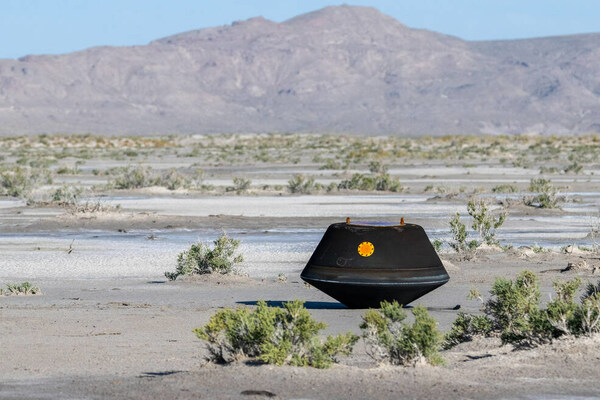Releases
The NASA mission – designed, built and flown by Lockheed Martin – aims to uncover new learnings about the building blocks of life in our solar system
UTAH TEST AND TRAINING RANGE, Utah, Sept. 24, 2023 /PRNewswire/ -- Following a rapid and red-hot descent through Earth's atmosphere, NASA's OSIRIS-REx sample return capsule touched down in the desert at 8:52 a.m. MT today, returning NASA's first-ever asteroid sample. The capsule is estimated to hold about a cup of material from Bennu, a carbon-rich asteroid. Scientists hope it will teach us more about the origin of organics that led to life on Earth and help us better understand planet formation.
Just prior to landing, the capsule entered the atmosphere traveling more than 27,000 mph. It then gently landed in the sands of the U.S. government's Utah Test and Training Range.
A specialized recovery team led by Lockheed Martin [NYSE: LMT] – who designed, built and currently flies the mission for NASA – comprising representatives from NASA's Goddard Space Flight Center, NASA Johnson Space Center, the University of Arizona, then secured the capsule.
"The landing was safe, recovery was a huge success, and we're thrilled that the next phase of this mission can now begin," said Kyle Griffin, vice president and general manager of Commercial Civil Space at Lockheed Martin. "This particular sample return is monumental – scientists are about to open a time capsule with some of the earliest history of our solar system inside."
After approaching the capsule landing area in helicopters, the recovery team carefully searched for any hazardous material, sampled the neighboring soil, wrapped the 100-lb capsule in protective material, and attached it for transport with via helicopter to an on-site cleanroom at the range. There, the sample is being processed for shipment on a military aircraft to curation team members at NASA Johnson in Houston, Texas, who will make it available for study.
In total, about 60 people from NASA, the University of Arizona, Lockheed Martin and range personnel took part in the capsule landing and recovery efforts, plus a team of about 25 engineers operating the spacecraft from Lockheed Martin's Mission Support Area in Denver.
Advanced Exploration Technology Testbed
The OSIRIS-REx mission pioneered key technologies relevant to the future exploration of small bodies in our solar system, beyond its immediate follow-on mission. They include:
- Specific techniques for operating in microgravity
- Autonomous guidance to the surface of a small body with Natural Feature Tracking
- Unique sample collection from an asteroid, with the Lockheed Martin-invented, reverse-vacuum Touch and Go sample Acquisition Mechanism (TAGSAM) device
Next Stop: Apophis
Following today's successful landing and showcase of key technologies, OSIRIS-REx will now be dubbed OSIRIS-APEX and enter its extended mission phase, beginning its journey to its follow-on mission target: near-Earth asteroid Apophis.
To date, OSIRIS-REx's major mission milestones include:
- Launching on Sept. 8, 2016, from Cape Canaveral Space Force Station.
- Arriving at Bennu on Dec. 3, 2018, where it conducted a two-year detailed survey of the asteroid.
- Extracting a sample from the asteroid by "tagging" it on Oct. 20, 2020.
- Departing the asteroid to head back to Earth on May 10, 2021.
Background and Resources
Including OSIRIS-REx, Lockheed Martin has built more interplanetary spacecraft than all other U.S. companies combined and has partnered with NASA to explore every planet in our solar system. The company is excited to continue its legacy of supporting every NASA robotic sample return mission to date with its upcoming work on the agency's Mars Sample Return program.
More Lockheed Martin OSIRIS-REx resources include:
- Lockheed Martin's OSIRIS-REx webpage
- Photos of OSIRIS-REx
- OSIRIS-REx sample return video
About the OSIRIS-REx Mission
NASA's Goddard Space Flight Center in Greenbelt, Maryland, provides overall mission management, systems engineering, and the safety and mission assurance for OSIRIS-REx. The University of Arizona leads the science team and the mission's science observation planning and data processing. Lockheed Martin Space in Littleton, Colorado, built the spacecraft and provides flight operations.
About Lockheed Martin
Headquartered in Bethesda, Maryland, Lockheed Martin Corporation is a global security and aerospace company that employs approximately 116,000 people worldwide and is principally engaged in the research, design, development, manufacture, integration and sustainment of advanced technology systems, products and services.
Please follow @LMNews on X for the latest announcements and news across the corporation.
SOURCE Lockheed Martin




